S.L. Viehl's Blog, page 183
October 15, 2011
NaNo Badges
As I've done the last couple years of NaNoWriMo, I've uploaded their participant web badges to my Photobucket account for those who don't have any place to park images. If you'd like to use one for your blog or site, just hover your cursor over the badge below to get the URL.
 [image error]
[image error] 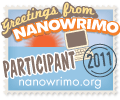


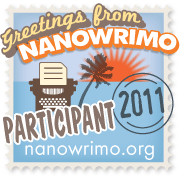 [image error]
[image error] 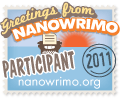 [image error]
[image error] 
[image error] [image error] [image error]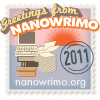

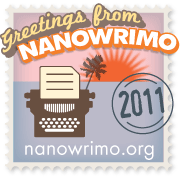
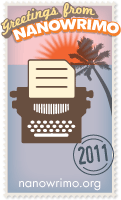
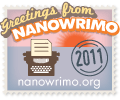
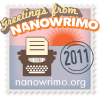


 [image error]
[image error] 


 [image error]
[image error]  [image error]
[image error] 
[image error] [image error] [image error]







Published on October 15, 2011 21:00
October 14, 2011
Breathtaking
I love time-lapse landscape videos like this. Something about seeing the captured movements and interplay of the light and sky and land is thrilling and comforting at the same time. This one looks particularly cool when you full-screen it, too.
Landscapes: Volume Two from Dustin Farrell on Vimeo.
Landscapes: Volume Two from Dustin Farrell on Vimeo.
Published on October 14, 2011 21:00
October 13, 2011
Mini-Project #2: Journal Cover
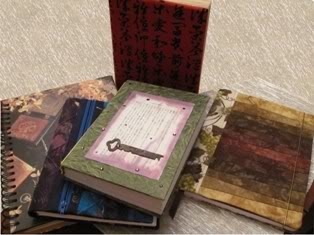 I've been keeping a daily handwritten journal since 1974, and each year I fill up at least a dozen, sometimes more. I also love to give beautiful blank journals as gifts (and as a nudge to do more non-electronic writing.) I often purchase the journals I use from some very talented journal makers over on Etsy.com, but I also like to make or makeover my own.
I've been keeping a daily handwritten journal since 1974, and each year I fill up at least a dozen, sometimes more. I also love to give beautiful blank journals as gifts (and as a nudge to do more non-electronic writing.) I often purchase the journals I use from some very talented journal makers over on Etsy.com, but I also like to make or makeover my own.My favorite journals to makeover are the ones no one wants; the premade blank books that you see in the scratch-n-dent discount bins at the bookstore. I always feel like I'm rescuing them. The biggest problem with discounted premades is that they generally have dinged, soiled or unsightly covers, but that's easy to fix with a new cover.
The journal covers I make are simply larger versions of a mug mat that are sized, wrapped around and sewn onto a premade blank book. To make one, you'll need a journal to cover, two pieces of fabric, batting if desired, binding if desired, pins, needle, measuring tape and thread.
Before you begin, you will need to do some measuring and some math. To cover a journal, you want to cut your fabric according to these calculations:
Width of fabric = width of front cover + width of back cover + width of spine + width of 2 inner flaps + 1/2" for seam allowances.
Length of fabric = length of front cover + 1/2" for seam allowances.
The inner flaps can be any width you desire up to the total width of the front or back cover. I don't like wide flaps so I size mine around two or three inches. Also, if you plan to use batting and quilt the piece, I suggest adding 1/8" to 1/4" to the width as well as the length of your fabric to allow for the pull of the loft.
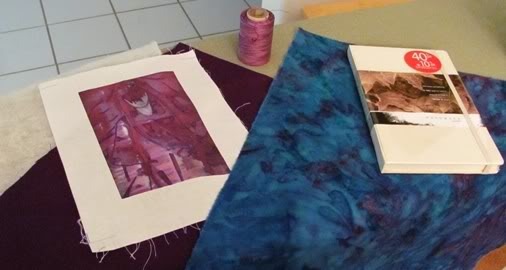
If the journal you're covering is in the pocket-size range and you don't want to mess with binding, you can sew it the same way I made the mug mat, by placing your top and bottom fabrics right sides together and sewing around the edges, leaving a gap for turning.
If your journal is paperback book size or bigger and needs a larger piece to cover it, it's probably best to make your cover like a mini-quilt: with the right sides facing out, sandwich your fabrics together (batting goes in the middle), pin or baste-stitch together, quilt as desired and bind with bias binding.

Fabric and thread choices are where you can get really creative and have fun with this project. Because I was working with the vral image test swatch I ordered from Spoonflower, for the outer cover I pieced it with some fabric hand-dyed by an old friend of mine, then quilted the vral patch with matching variegated thread and my friend's fabric with metallic Sulky. For the inside/backing fabric I used a solid color piece to match the binding because it won't be seen.
[image error]
Once you've completed your cover, fit it to the journal and whip or blind-stitch the top and bottom edges of both inner flaps to the edge of the front and back cover edges to hold it in place (you can also use tacky or hot glue but I find that tends to be messy and leaves glue spots showing on the fabric.) Another bonus of sewing the flaps is that it creates an inner pocket where you can stow a pen or bits and pieces or use it as a page tuck.
Journals with handmade covers are great for kids, loved ones, writer friends or any notebook junkie. Personalize the fabric you use for your cover to suit your recipient, then pair it with a pretty pen, a box of photo corners or a CD of music to write by, and you've got a terrific gift for any occasion.
Published on October 13, 2011 21:00
October 12, 2011
Very Superstitious
Colossal Art & Design has a neat pictoral post here about money trees, and notes:
Apparently in several wooded areas around the UK, passersby have been stopping for decades (if not centuries), meticulously hammering small denomination coins intro trees . . . the practice might date back to the early 1700s in Scotland where ill people stuck florins into trees with the idea that the tree would take away their sickness.
I don't think spiking a tree with coins will ward off illness, but I am heavily invested in my own belief that drinking a glass of orange juice every day prevents colds (and since I've only had two in the last five years, there may be something to that.) I have no problem with the number thirteen; it's eight that always makes me a little nervous. Black cats can cross my path any time, but I won't voluntarily walk under a ladder -- and that's just common sense; I've treated too many people who did and got head injuries. Wearing something green seems to help me write better or otherwise brings me a little luck.
Probably my worst superstition is that I flatly refuse to look at anyone when for any reason we physically part ways; three times in the past I've watched someone leaving until they were out of sight and all three died before I could see them again. Do I think me watching them go made them die? Not at all. So why don't I put aside my silly superstition and watch and wave goodbye? I guess it's because I could be wrong.
Bestowing on your characters such habits is one more way of breathing life into them. Traditional superstitions are not your only choices; you can invent a ritual or avoidance behavior tailored to your character's personality, setting and/or backstory. The superstition doesn't have to be logical to anyone but the character, either. A protagonist who grew up desperately poor might keep money in strange places, or compulsively collect piggy banks, or can't pass a homeless shelter without going in to make a donation. A character who nearly died in a bad car crash might hang a good-luck object from their rearview mirror (maybe even something from the car that crashed.)
It's a good idea to research your character's cultural background and learn about their superstitions, as these are often passed down through the generations. Foe example, the numbers four and nine are considered bad luck by the Japanese for these reasons:
The number four is pronounced as "shi" in Japanese, and is the word for death. The number nine is pronounced "ku" and rhymes with "kutsuu" which means pain in Japanese. The number four and two together are pronounced "shi-ni" which means to die and as a result the number forty-two is considered unlucky as is number twenty-four or "ni-shi" meaning double death.*
Now I'm off to finish basting a quilt piece I was working on this morning. If you leave a seam undone for too long your thread will become mysteriously/hopelessly snarled and you'll have to pick it out and sew it over; ask any quilter. This is because you gave the devil ample time to mess with it . . .
Related links:
Corsinet.com has collected lengthy A-L and M-Z alphabetized lists of superstitions.
The Origins of 7 Common Superstitions by Jill Harness
Urban Legends Online is an excellent resource for all manner of superstitions
*from The Unusual Superstitions of the Japanese by Shane Sakata
Money Trees article link swiped from Gerard over at The Presurfer.
Apparently in several wooded areas around the UK, passersby have been stopping for decades (if not centuries), meticulously hammering small denomination coins intro trees . . . the practice might date back to the early 1700s in Scotland where ill people stuck florins into trees with the idea that the tree would take away their sickness.
I don't think spiking a tree with coins will ward off illness, but I am heavily invested in my own belief that drinking a glass of orange juice every day prevents colds (and since I've only had two in the last five years, there may be something to that.) I have no problem with the number thirteen; it's eight that always makes me a little nervous. Black cats can cross my path any time, but I won't voluntarily walk under a ladder -- and that's just common sense; I've treated too many people who did and got head injuries. Wearing something green seems to help me write better or otherwise brings me a little luck.
Probably my worst superstition is that I flatly refuse to look at anyone when for any reason we physically part ways; three times in the past I've watched someone leaving until they were out of sight and all three died before I could see them again. Do I think me watching them go made them die? Not at all. So why don't I put aside my silly superstition and watch and wave goodbye? I guess it's because I could be wrong.
Bestowing on your characters such habits is one more way of breathing life into them. Traditional superstitions are not your only choices; you can invent a ritual or avoidance behavior tailored to your character's personality, setting and/or backstory. The superstition doesn't have to be logical to anyone but the character, either. A protagonist who grew up desperately poor might keep money in strange places, or compulsively collect piggy banks, or can't pass a homeless shelter without going in to make a donation. A character who nearly died in a bad car crash might hang a good-luck object from their rearview mirror (maybe even something from the car that crashed.)
It's a good idea to research your character's cultural background and learn about their superstitions, as these are often passed down through the generations. Foe example, the numbers four and nine are considered bad luck by the Japanese for these reasons:
The number four is pronounced as "shi" in Japanese, and is the word for death. The number nine is pronounced "ku" and rhymes with "kutsuu" which means pain in Japanese. The number four and two together are pronounced "shi-ni" which means to die and as a result the number forty-two is considered unlucky as is number twenty-four or "ni-shi" meaning double death.*
Now I'm off to finish basting a quilt piece I was working on this morning. If you leave a seam undone for too long your thread will become mysteriously/hopelessly snarled and you'll have to pick it out and sew it over; ask any quilter. This is because you gave the devil ample time to mess with it . . .
Related links:
Corsinet.com has collected lengthy A-L and M-Z alphabetized lists of superstitions.
The Origins of 7 Common Superstitions by Jill Harness
Urban Legends Online is an excellent resource for all manner of superstitions
*from The Unusual Superstitions of the Japanese by Shane Sakata
Money Trees article link swiped from Gerard over at The Presurfer.
Published on October 12, 2011 21:00
October 11, 2011
This and That
 I've received several invitations (or possibly some weird kind of SPAM) from Goodreads asking me to "claim" my author page. Here's the problem: a while back I discovered that Goodreads was bootlegging my blog content and posting it on their site without my permission. I contacted them and politely told them to stop it. They didn't feel copying my content was wrong, but agreed to remove it. Only what they really did was move it elsewhere on their site by posting it under another of my pseudonyms. I guess they thought I wouldn't noticed. So anyway, in the event this isn't weird SPAM, no, I won't be claiming anything that has to do with Goodreads.
I've received several invitations (or possibly some weird kind of SPAM) from Goodreads asking me to "claim" my author page. Here's the problem: a while back I discovered that Goodreads was bootlegging my blog content and posting it on their site without my permission. I contacted them and politely told them to stop it. They didn't feel copying my content was wrong, but agreed to remove it. Only what they really did was move it elsewhere on their site by posting it under another of my pseudonyms. I guess they thought I wouldn't noticed. So anyway, in the event this isn't weird SPAM, no, I won't be claiming anything that has to do with Goodreads.I have adjusted down my total published stats over there on the sidebar; the explanation as to why can be read on the Backlist/Bibliography page.
Finally, my agent kindly sent me a few extra ARCs for Nightshine , my fourth and final Kyndred novel, which will be released next month. As I already did a general giveaway for the ARCs my publisher sent me, I thought I'd do something different with these. Any suggestions? Let me know in comments.
Published on October 11, 2011 21:00
October 10, 2011
Color Reference Notebook
Over the years I've collected or put together so many color-related swatches, charts, pamphlets, palettes and word lists that I decided to consolidate them in one reference notebook. That way the next time I need to describe a particular shade of white I can have all the whites I've saved in one place.
Color referencing in fiction can be tricky, as I think the writer's first tendency is to grab a cliche or relate something to food. Who hasn't read at least one story in which a frightened character went white as a sheet, or possessed flawless creamy-white skin? But we know this is really lazy writing, and we owe the reader a bit more originality and effort.
I started my notebook with white, which happens to be my color reference nemesis. I discovered how difficult it is to describe white when I made the eyes of my Jorenian characters in the StarDoc series that color -- and subsequently cursed myself for doing so for the next thirteen years. All my color references to white were contemporary, and here I was writing in a far future where 99% of them didn't exist. Anyway, most of the time I fell back on a blind-person analogy or the white-within-white thing. It was lame, and it's probably the reason I started collecting color references in the first place, to broaden my understanding of color as well as beef up my descriptive powers.

We all see and respond to color differently, so this kind of notebook is a great exercise in originality. You can put anything that inspires you in a color reference notebook; what you want is something that naturally stimulates your powers of description. I find combining paint charts and photos with word lists related to the color usually primes the well for me, but I also plan to use cover art, scanned images from my favorite magazines (Artful Blogging has tons of ladies who do the all-white decorating thing) as well as poems I associate with particular colors or palettes. Here's a page with Stopping by Woods on a Snowy Evening by Robert Frost, definitely my #1 white poem:
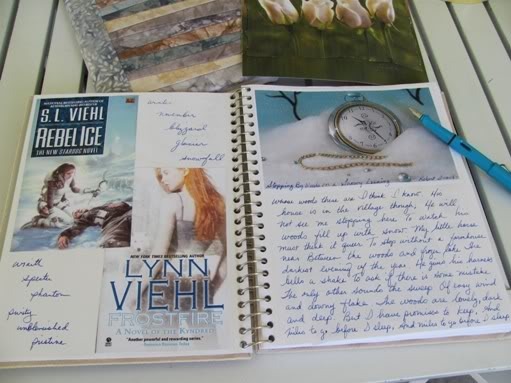
A color reference notebook is also a good storage encyclopedia for references you've already used in stories past. This can help prevent you from becoming that a descriptive repeater who in every book has a character with chocolate brown eyes or flaming red hair. Doesn't seem like it would be a problem, but wait until you've written twenty or thirty novels and suddenly you notice that every other guy character you write has laser-beam blue eyes.
What would you put in a color reference notebook to help jog your descriptive powers? Let us know in comments.
Related posts:
Color referencing in fiction can be tricky, as I think the writer's first tendency is to grab a cliche or relate something to food. Who hasn't read at least one story in which a frightened character went white as a sheet, or possessed flawless creamy-white skin? But we know this is really lazy writing, and we owe the reader a bit more originality and effort.
I started my notebook with white, which happens to be my color reference nemesis. I discovered how difficult it is to describe white when I made the eyes of my Jorenian characters in the StarDoc series that color -- and subsequently cursed myself for doing so for the next thirteen years. All my color references to white were contemporary, and here I was writing in a far future where 99% of them didn't exist. Anyway, most of the time I fell back on a blind-person analogy or the white-within-white thing. It was lame, and it's probably the reason I started collecting color references in the first place, to broaden my understanding of color as well as beef up my descriptive powers.

We all see and respond to color differently, so this kind of notebook is a great exercise in originality. You can put anything that inspires you in a color reference notebook; what you want is something that naturally stimulates your powers of description. I find combining paint charts and photos with word lists related to the color usually primes the well for me, but I also plan to use cover art, scanned images from my favorite magazines (Artful Blogging has tons of ladies who do the all-white decorating thing) as well as poems I associate with particular colors or palettes. Here's a page with Stopping by Woods on a Snowy Evening by Robert Frost, definitely my #1 white poem:

A color reference notebook is also a good storage encyclopedia for references you've already used in stories past. This can help prevent you from becoming that a descriptive repeater who in every book has a character with chocolate brown eyes or flaming red hair. Doesn't seem like it would be a problem, but wait until you've written twenty or thirty novels and suddenly you notice that every other guy character you write has laser-beam blue eyes.
What would you put in a color reference notebook to help jog your descriptive powers? Let us know in comments.
Related posts:
Published on October 10, 2011 21:00
October 9, 2011
Sub Ops Ten
Ten Things About Submission Opportunities
The Jim Baen Memorial Contest is now open for entries: "Write a short story of no more than 8,000 words, that shows the near future (no more than about 50-60 years out) of manned space exploration." What they'd like to see: "Moon bases, Mars colonies, orbital habitats, space elevators, asteroid mining, artificial intelligence, nano-technology, realistic spacecraft, heroics, sacrifice, adventure." What they don't want to see: "Stories that show technology or space travel as evil or bad, Star Wars type galactic empires, paranormal elements, UFO abductions." Prizes: "The GRAND PRIZE winner will be published as the featured story on the Baen Books main website and paid at the normal paying rates for professional story submittals. The author will also receive an engraved award, free entry into the 2012 International Space Development Conference, a year's membership in the National Space Society and a prize package containing various Baen Books and National Space Society merchandise. - SECOND and THIRD place winners will receive a year's membership in the National Space Society and a prize package containing various Baen Books and National Space Society merchandise." No entry fee, no reprints, electronic submission only, see contest page for more details. Deadline: February 1, 2012.
Bull Spec is open to fiction submissions: "What I'm looking for: amazing speculative fiction (science fiction, fantasy, slipstream, etc.) of any subgenre. What I'd like to see more of: (1) near or further future science fiction with a more optimistic voice and picture of our shared future; (2) well-written non-contemporary fantasy. Note: I'm unlikely to like your story if it has significant amounts of graphic violence or sex, trebly so if it's gratuitous." On length, the editor notes: "I'll read from about 1000 words (soft edges) to 8000 words (soft edges) but my sweet spot is in the 2000-4000 word range." On payment, Ralan notes: "Pay: 5¢/word advance (reprints: 1¢/word), 50% donation royalty" Reprints less than 10K okay but query on 10K or over, electronic submissions only, see guidelines for more details.
Cafe Doom is holding their seventh annual horror short story contest: "We're looking for the best in original horror fiction in 3000 words or less: classically-styled tales in the tradition of writers like Richard Mattheson, Stephen King and Robert Bloch, yet wholly original and modern. We're open to all themes and subgenres, as long as it's effectively written and, above all, scary." On prizes, the editor notes: "1st place - Pro rate of pay, plus publication by One Buck Horror. 2nd place - $100 Amazon voucher. 3rd place - $50 Amazon voucher. In addition to this I will give One Buck Horror anthologies to the authors of my three favourite stories." No reprints, electronic submissions only, see announcement for more details. Deadline: October 30, 2011
Carina Press has an open call for Holiday-themed SF novellas: "Carina is looking for science fiction novellas with a winter holiday theme, to be published digitally both individually and as a collection in December 2012. The novellas should be from 18,000 to 35,000 words and feature science fiction elements as integral to the novella. The stories do not need to be romance, or even have romance elements, but can be straight science fiction, or science fiction with romantic elements, and can also feature elements of mystery, thriller, horror or other sub-genres. Additionally, there is no set heat level for these stories, so they can have no sex, or be ultra-sexy, or anything in between." Payment, reprints: not specified. Electronic submission only, see blog announcement for more details. Deadline: March 15, 2012.
Daily Science Fiction is looking for submissions: "We need short short fiction, especially flash fiction. Among our featured stories, a shorter tale will get an extra nudge on the scale when weighed against a longer one. This is both for financial reasons and because it matches the preferences of a plurality of our readership. Not fair? Perhaps. Consider yourself forewarned. Of course, we want your stories to ooze originality, but a well-written story is a must. We are fond of character-driven fiction, and quite prosaic in our expectation that most stories we publish will in fact have a discernible plot. Wow us, make us care, create a conflict and resolve it. Note that this does not mean we will only publish character-driven masterworks with a plot that would make Tim Powers blush with envy. Our goal is to publish the best stories we can that will be interesting, worthwhile reads. Some stories, especially the shortest of the short short fiction, will succeed despite lack of plot, character, punctuation, what-have-you. We may purchase dark fantasy, but will not publish pure horror. We don't mind feeling the flush of arousal, but will not publish erotica. Guns a-blazing might make our day, but we don't suspect most military SF will win us over. Humor? We take it, It often works especially for short short fiction, but do keep in mind that one alien's funny bone is located near another species' sac of indifference. We're likely not your best market for longer funny tales. Don't be witless, but don't rely on a pun or a punchline to sell to DSF." Length: accepts 100 words to 10K with an emphasis on shorter stories, pays "...8 cents per word for first worldwide rights and for nonexclusive reprint rights. Additionally, we reserve the right to pay you more money for additional reprinting in themed Daily Science Fiction anthologies." No reprints, electronic submission by online form only, see guidelines for more details.
While they've been closed to submissions for a while, I thought it was worthy to note that Paula Guran will no longer be editing Pocket's Juno Books; some details here.
Megazanthus Press has an open call for their classical-music themed horror antho: "DF Lewis is intending to publish a Horror anthology book with the above title in 2012. (Horror stories, Weird Literature or Ghost Fiction.) Each story must feature in some way Classical Music, i.e. from Bach to Britten." Length: 2K-10K, Payment: "1p (£0.01) per word", no reprints, electronic submission only, see guidelines for more details. Deadline: May 30, 2012.
Stone Telling webzine has opened a reading period from September 23 - November 27 for science fiction poetry, and they're looking for: ". . . literary speculative poems with a strong emotional core. We focus on fantasy, science fiction, surrealism, and slipstream, but would consider outstanding science poetry and non-speculative poetry that fits the flavor of the magazine. Please note that we are not a mainstream literary poetry market, and non-speculative poetry will be an extremely hard sell. While we are open to all speculative poetry, we are especially interested in seeing work that is multi-cultural and boundary-crossing, work that deals with othering and Others, work that considers race, gender, sexuality, identity, and disability issues in nontrivial and evocative ways. We'd love to see multilingual poetry, though that can sometimes be tricky. Try us! There are no style limitations, but rhymed poetry will be a hard sell. Please try us with visual poetry, prose poetry, and other genre-bending forms. We will consider experimental poetry, but please remember that not all experimental poems are easy to represent in an e-zine format." Payment" $5, query on reprints, electronic submission only, see guidelines for more details.
Strange Horizons is once again open to submissions; in fiction they're looking for: ". . . good speculative fiction. If your story doesn't have a clear fantasy or science fiction element, or at least strong speculative-fiction sensibilities, it's probably not for us. We'd like to help make the field of speculative fiction more inclusive, more welcoming to both authors and readers from traditionally underrepresented groups, so we're interested in seeing stories from diverse perspectives and backgrounds. We want stories that have some literary depth but aren't boring; styles that are unusual yet readable; structures that balance inventiveness with traditional narrative. We like characters we can care about. We like settings and cultures that we don't see all the time in speculative fiction, as long as they're well-researched and not exoticized. We like stories that address political issues in complex and nuanced ways. However, we don't like heavy-handed or preachy or simplistic approaches." Length: 5-9K; prefers 5K or less, Payment: 7¢(US)/word, with a minimum payment of $50, no reprints, electronic submission via online form only, see guidelines for more details.
Withersin Press has opened a special reading period for fiction novella submissions from December 2011-April 2012: "Please send innovative ideas. We love razor wire fiction. We enjoy experimental fiction. We get gooey eyed over a well crafted, blood curdling plot line. Science fiction that pushes our buttons and considers new paradigms (and aliens!) will be well received. Don't send stories about unicorns and fairy princes. Or bimbos who fall for vampires. In fact, unless we specifically call for vampire stories, we don't want 'em. Challenge yourself. Stay away from clichéd plot lines. And don't send stories belittling our military. We are proud of our servicemen and women. Write well, write often, and write for the love of it!" Length: 15K-35K, payment: 10% of retail, no reprints, electronic submissions only, see guidelines for more details.
Most of the above sub ops came from the always marvelous market listings at Ralan.com.
The Jim Baen Memorial Contest is now open for entries: "Write a short story of no more than 8,000 words, that shows the near future (no more than about 50-60 years out) of manned space exploration." What they'd like to see: "Moon bases, Mars colonies, orbital habitats, space elevators, asteroid mining, artificial intelligence, nano-technology, realistic spacecraft, heroics, sacrifice, adventure." What they don't want to see: "Stories that show technology or space travel as evil or bad, Star Wars type galactic empires, paranormal elements, UFO abductions." Prizes: "The GRAND PRIZE winner will be published as the featured story on the Baen Books main website and paid at the normal paying rates for professional story submittals. The author will also receive an engraved award, free entry into the 2012 International Space Development Conference, a year's membership in the National Space Society and a prize package containing various Baen Books and National Space Society merchandise. - SECOND and THIRD place winners will receive a year's membership in the National Space Society and a prize package containing various Baen Books and National Space Society merchandise." No entry fee, no reprints, electronic submission only, see contest page for more details. Deadline: February 1, 2012.
Bull Spec is open to fiction submissions: "What I'm looking for: amazing speculative fiction (science fiction, fantasy, slipstream, etc.) of any subgenre. What I'd like to see more of: (1) near or further future science fiction with a more optimistic voice and picture of our shared future; (2) well-written non-contemporary fantasy. Note: I'm unlikely to like your story if it has significant amounts of graphic violence or sex, trebly so if it's gratuitous." On length, the editor notes: "I'll read from about 1000 words (soft edges) to 8000 words (soft edges) but my sweet spot is in the 2000-4000 word range." On payment, Ralan notes: "Pay: 5¢/word advance (reprints: 1¢/word), 50% donation royalty" Reprints less than 10K okay but query on 10K or over, electronic submissions only, see guidelines for more details.
Cafe Doom is holding their seventh annual horror short story contest: "We're looking for the best in original horror fiction in 3000 words or less: classically-styled tales in the tradition of writers like Richard Mattheson, Stephen King and Robert Bloch, yet wholly original and modern. We're open to all themes and subgenres, as long as it's effectively written and, above all, scary." On prizes, the editor notes: "1st place - Pro rate of pay, plus publication by One Buck Horror. 2nd place - $100 Amazon voucher. 3rd place - $50 Amazon voucher. In addition to this I will give One Buck Horror anthologies to the authors of my three favourite stories." No reprints, electronic submissions only, see announcement for more details. Deadline: October 30, 2011
Carina Press has an open call for Holiday-themed SF novellas: "Carina is looking for science fiction novellas with a winter holiday theme, to be published digitally both individually and as a collection in December 2012. The novellas should be from 18,000 to 35,000 words and feature science fiction elements as integral to the novella. The stories do not need to be romance, or even have romance elements, but can be straight science fiction, or science fiction with romantic elements, and can also feature elements of mystery, thriller, horror or other sub-genres. Additionally, there is no set heat level for these stories, so they can have no sex, or be ultra-sexy, or anything in between." Payment, reprints: not specified. Electronic submission only, see blog announcement for more details. Deadline: March 15, 2012.
Daily Science Fiction is looking for submissions: "We need short short fiction, especially flash fiction. Among our featured stories, a shorter tale will get an extra nudge on the scale when weighed against a longer one. This is both for financial reasons and because it matches the preferences of a plurality of our readership. Not fair? Perhaps. Consider yourself forewarned. Of course, we want your stories to ooze originality, but a well-written story is a must. We are fond of character-driven fiction, and quite prosaic in our expectation that most stories we publish will in fact have a discernible plot. Wow us, make us care, create a conflict and resolve it. Note that this does not mean we will only publish character-driven masterworks with a plot that would make Tim Powers blush with envy. Our goal is to publish the best stories we can that will be interesting, worthwhile reads. Some stories, especially the shortest of the short short fiction, will succeed despite lack of plot, character, punctuation, what-have-you. We may purchase dark fantasy, but will not publish pure horror. We don't mind feeling the flush of arousal, but will not publish erotica. Guns a-blazing might make our day, but we don't suspect most military SF will win us over. Humor? We take it, It often works especially for short short fiction, but do keep in mind that one alien's funny bone is located near another species' sac of indifference. We're likely not your best market for longer funny tales. Don't be witless, but don't rely on a pun or a punchline to sell to DSF." Length: accepts 100 words to 10K with an emphasis on shorter stories, pays "...8 cents per word for first worldwide rights and for nonexclusive reprint rights. Additionally, we reserve the right to pay you more money for additional reprinting in themed Daily Science Fiction anthologies." No reprints, electronic submission by online form only, see guidelines for more details.
While they've been closed to submissions for a while, I thought it was worthy to note that Paula Guran will no longer be editing Pocket's Juno Books; some details here.
Megazanthus Press has an open call for their classical-music themed horror antho: "DF Lewis is intending to publish a Horror anthology book with the above title in 2012. (Horror stories, Weird Literature or Ghost Fiction.) Each story must feature in some way Classical Music, i.e. from Bach to Britten." Length: 2K-10K, Payment: "1p (£0.01) per word", no reprints, electronic submission only, see guidelines for more details. Deadline: May 30, 2012.
Stone Telling webzine has opened a reading period from September 23 - November 27 for science fiction poetry, and they're looking for: ". . . literary speculative poems with a strong emotional core. We focus on fantasy, science fiction, surrealism, and slipstream, but would consider outstanding science poetry and non-speculative poetry that fits the flavor of the magazine. Please note that we are not a mainstream literary poetry market, and non-speculative poetry will be an extremely hard sell. While we are open to all speculative poetry, we are especially interested in seeing work that is multi-cultural and boundary-crossing, work that deals with othering and Others, work that considers race, gender, sexuality, identity, and disability issues in nontrivial and evocative ways. We'd love to see multilingual poetry, though that can sometimes be tricky. Try us! There are no style limitations, but rhymed poetry will be a hard sell. Please try us with visual poetry, prose poetry, and other genre-bending forms. We will consider experimental poetry, but please remember that not all experimental poems are easy to represent in an e-zine format." Payment" $5, query on reprints, electronic submission only, see guidelines for more details.
Strange Horizons is once again open to submissions; in fiction they're looking for: ". . . good speculative fiction. If your story doesn't have a clear fantasy or science fiction element, or at least strong speculative-fiction sensibilities, it's probably not for us. We'd like to help make the field of speculative fiction more inclusive, more welcoming to both authors and readers from traditionally underrepresented groups, so we're interested in seeing stories from diverse perspectives and backgrounds. We want stories that have some literary depth but aren't boring; styles that are unusual yet readable; structures that balance inventiveness with traditional narrative. We like characters we can care about. We like settings and cultures that we don't see all the time in speculative fiction, as long as they're well-researched and not exoticized. We like stories that address political issues in complex and nuanced ways. However, we don't like heavy-handed or preachy or simplistic approaches." Length: 5-9K; prefers 5K or less, Payment: 7¢(US)/word, with a minimum payment of $50, no reprints, electronic submission via online form only, see guidelines for more details.
Withersin Press has opened a special reading period for fiction novella submissions from December 2011-April 2012: "Please send innovative ideas. We love razor wire fiction. We enjoy experimental fiction. We get gooey eyed over a well crafted, blood curdling plot line. Science fiction that pushes our buttons and considers new paradigms (and aliens!) will be well received. Don't send stories about unicorns and fairy princes. Or bimbos who fall for vampires. In fact, unless we specifically call for vampire stories, we don't want 'em. Challenge yourself. Stay away from clichéd plot lines. And don't send stories belittling our military. We are proud of our servicemen and women. Write well, write often, and write for the love of it!" Length: 15K-35K, payment: 10% of retail, no reprints, electronic submissions only, see guidelines for more details.
Most of the above sub ops came from the always marvelous market listings at Ralan.com.
Published on October 09, 2011 21:00
October 8, 2011
Starring Words
This is a very cool, creative BYU student film using words to illustrate and demonstrate the importance of the five senses. I love how they used words as the actors.

Typophile Film Festival 5 Opening Titles from Brent Barson on Vimeo.
Published on October 08, 2011 21:00
October 7, 2011
Winner
I got a kick out of reading all the entries for the Prompted giveaway; you guys mentioned so many great resources, and many were completely unexpected.
We revved up the magic hat tonight, and the giveaway winner is:
traveler, who uses photo albums as creative prompts.
Traveler, when you have a chance please send your full name and ship-to address to LynnViehl@aol.com so I can get your book out to you. Thanks to everyone for joining in and sharing.
We revved up the magic hat tonight, and the giveaway winner is:
traveler, who uses photo albums as creative prompts.
Traveler, when you have a chance please send your full name and ship-to address to LynnViehl@aol.com so I can get your book out to you. Thanks to everyone for joining in and sharing.
Published on October 07, 2011 21:14
October 6, 2011
Mini-Projects
An update on the Spoonflower fabric: I've washed it according to the site's directions, and both the yardage and the test swatches came out fine; no color transfer or fading of the images, and only minimal fraying on the edges. Once washed the fabric has a nice, dense, cottony hand to it; almost like a lightweight linen. You will probably need to steam iron it to get out wrinkles.
For the yardage I designed I'm waiting on some companion fabrics, which should arrive next week, before I begin that project. That gives me the test swatches to work with, and I decided to make them into three mini-projects: a mug mat, a journal cover and a book bag.
Since these work well as gifts for writers or readers I thought I'd show you how to do each mini-project. Anyone with basic hand sewing skills or who can run a straight stitch on a sewing machine should be able to handle them with no problem.
Mini-Project #1: Mug Mat

A quilted mug mat, or fabric coaster, is made of two small pieces of fabric sewn together. You can put low-loft (thin) batting or a piece of soft flannel between them, but I like to use recycled dryer sheets.
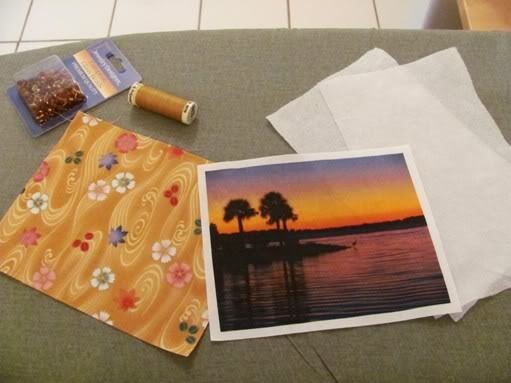
Cut two pieces of fabric and one piece of batting or lining material in the size you want plus 1/4" on all sides to create the seam allowance you'll need for sewing. Press and place the fabric with the right sides together (the wrong or undersides of the fabric should be facing out on both sides) and pin together around the edges. If you can't eyeball 1/4" or sew a straight line freehand, take a ruler and a pencil and lightly mark your sewing lines 1/4" from each edge.
Starting one inch from any corner, sew all the way around the fabrics but stop two inches from where you began (this creates a gap, which you'll use to turn your project inside out.) Baste or whip stitch a piece of batting, flannel or other lining to either side of fabric, sewing it in the same fashion to match the gap. Clip the corners and turn inside out, press and sew the gap closed with a blind stitch.
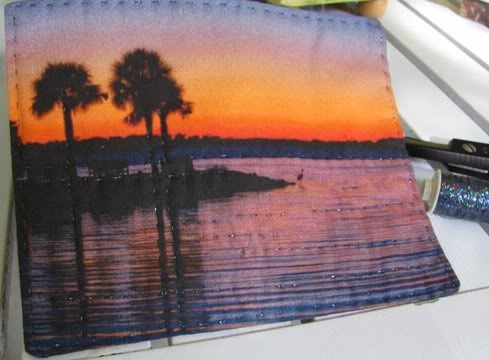
You can hand or machine quilt the mug mat however you like; because there's no binding I always run a stitch around the edges to secure the seams. For my mug mat I used a metallic Sulky and quilted random lines to give it a little sparkle. If you don't care for the edges you can sew a frame of lace or beads around the edges -- here's one I beaded along the edges -- but don't use anything dimensional to embellish the center of the mat as it needs to remain flat.
Writers, if you're handy with a sewing machine you should be able to make up a couple dozen of these over a weekend to give out at your next booksigning or appearance. I'd suggest either designing the mug mat on Spoonflower or using fabric that coordinates with your cover art or somehow relates to your story. You can ink jet on printable fabric panels your book and web site info for the bottom side (or you can write this on the bottom fabric with a fine-tipped Sharpie, too. Just tape down the fabric first; it tends to move when you try to write on it.)
For the winter holidays, a set of four or six mug mats stacked in a small, pretty box or rolled up and placed in a neat mug do make a nice friend or hostess gift, especially if you coordinate the fabric to match your recipient's decor.
For the yardage I designed I'm waiting on some companion fabrics, which should arrive next week, before I begin that project. That gives me the test swatches to work with, and I decided to make them into three mini-projects: a mug mat, a journal cover and a book bag.
Since these work well as gifts for writers or readers I thought I'd show you how to do each mini-project. Anyone with basic hand sewing skills or who can run a straight stitch on a sewing machine should be able to handle them with no problem.
Mini-Project #1: Mug Mat

A quilted mug mat, or fabric coaster, is made of two small pieces of fabric sewn together. You can put low-loft (thin) batting or a piece of soft flannel between them, but I like to use recycled dryer sheets.

Cut two pieces of fabric and one piece of batting or lining material in the size you want plus 1/4" on all sides to create the seam allowance you'll need for sewing. Press and place the fabric with the right sides together (the wrong or undersides of the fabric should be facing out on both sides) and pin together around the edges. If you can't eyeball 1/4" or sew a straight line freehand, take a ruler and a pencil and lightly mark your sewing lines 1/4" from each edge.
Starting one inch from any corner, sew all the way around the fabrics but stop two inches from where you began (this creates a gap, which you'll use to turn your project inside out.) Baste or whip stitch a piece of batting, flannel or other lining to either side of fabric, sewing it in the same fashion to match the gap. Clip the corners and turn inside out, press and sew the gap closed with a blind stitch.

You can hand or machine quilt the mug mat however you like; because there's no binding I always run a stitch around the edges to secure the seams. For my mug mat I used a metallic Sulky and quilted random lines to give it a little sparkle. If you don't care for the edges you can sew a frame of lace or beads around the edges -- here's one I beaded along the edges -- but don't use anything dimensional to embellish the center of the mat as it needs to remain flat.
Writers, if you're handy with a sewing machine you should be able to make up a couple dozen of these over a weekend to give out at your next booksigning or appearance. I'd suggest either designing the mug mat on Spoonflower or using fabric that coordinates with your cover art or somehow relates to your story. You can ink jet on printable fabric panels your book and web site info for the bottom side (or you can write this on the bottom fabric with a fine-tipped Sharpie, too. Just tape down the fabric first; it tends to move when you try to write on it.)
For the winter holidays, a set of four or six mug mats stacked in a small, pretty box or rolled up and placed in a neat mug do make a nice friend or hostess gift, especially if you coordinate the fabric to match your recipient's decor.
Published on October 06, 2011 21:00
S.L. Viehl's Blog
- S.L. Viehl's profile
- 224 followers
S.L. Viehl isn't a Goodreads Author
(yet),
but they
do have a blog,
so here are some recent posts imported from
their feed.



